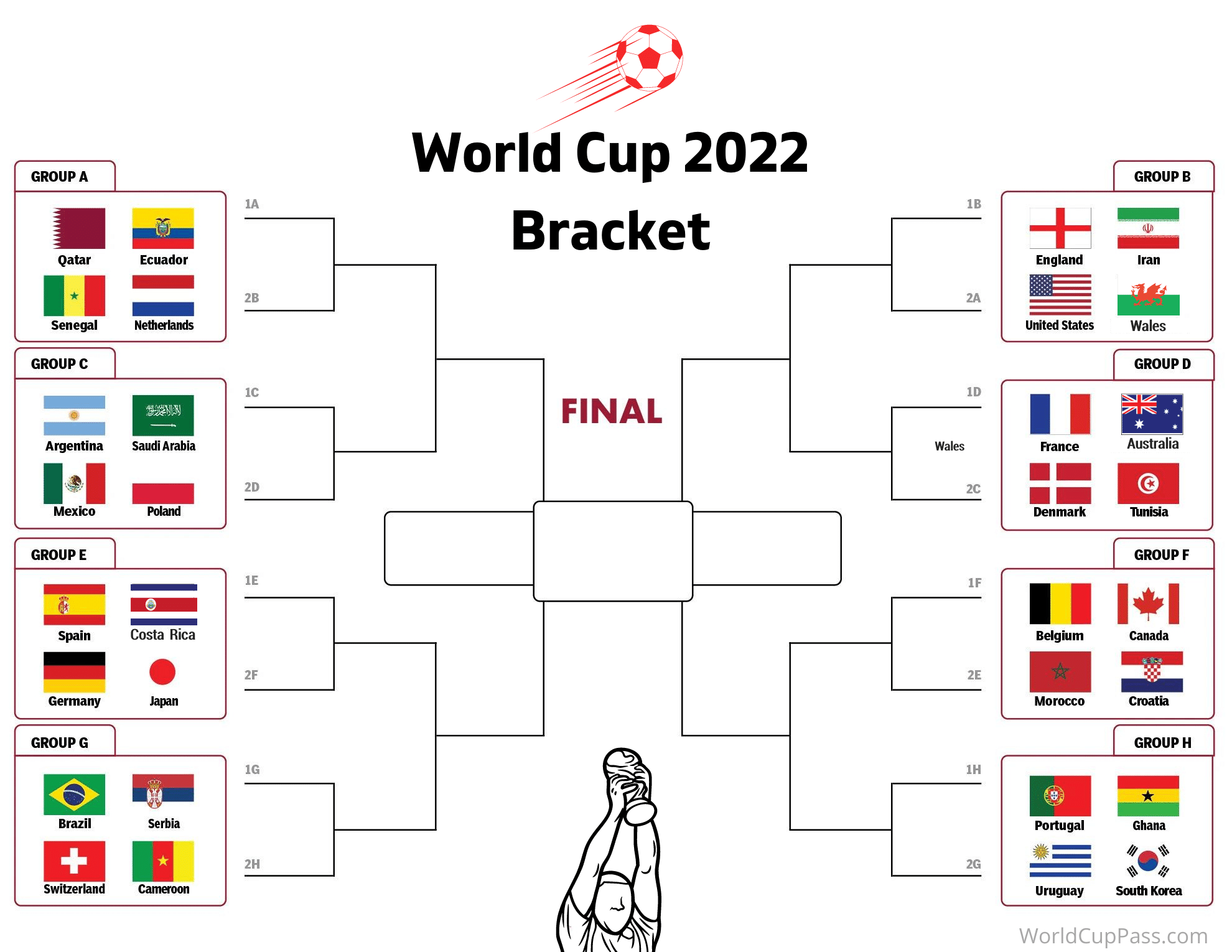Bracket for World Cup: Get ready to dive headfirst into the thrilling world of World Cup bracket predictions! From understanding the different bracket formats – think single-elimination showdowns versus the intricate group stage – to mastering prediction strategies and designing your own visually stunning bracket, we’ve got you covered. This isn’t just about picking winners; it’s about joining the global community of fans, engaging in friendly competition, and adding an extra layer of excitement to the biggest football tournament on Earth.
We’ll explore everything from the simplest bracket designs to complex scoring systems, offering tips and tricks to help you refine your predictive prowess. Whether you’re a seasoned bracket pro or a first-timer, this guide will equip you with the knowledge and tools to conquer the World Cup bracket challenge. Prepare for some serious fun!
Bracket Creation and Design
Creating a World Cup bracket is more than just filling in names; it’s a design challenge blending visual appeal with functional clarity. A well-designed bracket ensures easy tracking of matches and provides a satisfying user experience, whether printed or viewed online. The process involves careful planning and consideration of several key elements.
The fundamental steps involve defining the tournament structure, determining the visual representation, and finally, incorporating a scoring system. This process allows for the creation of a bracket that is both informative and engaging for users, providing a clear pathway to follow the progression of teams throughout the tournament.
Bracket Structure Definition
Defining the tournament structure is the crucial first step. This involves understanding the number of teams participating and how they will be seeded and matched. For the FIFA World Cup, this is a complex process involving rankings and geographical considerations. The bracket itself reflects this structure, typically using a single-elimination format where teams play until only one remains. The number of rounds depends on the number of teams; for example, a 32-team tournament like the World Cup requires 5 rounds to determine a champion.
Each round is visually represented by a level in the bracket.
Discover the crucial elements that make world cup cup winners list the top choice.
Visual Representation Methods
Several methods exist for visually representing a bracket. The most common is the tree diagram, a hierarchical structure where each match is represented by a node, and the branches lead to the next round’s matches. This clearly shows the progression of teams and the winner of each match. Another method is a grid-based representation, which arranges matches in rows and columns.
While less visually intuitive than a tree diagram, it can be easier to print and fit on a page, particularly for larger tournaments. The choice depends on the desired balance between visual clarity and space constraints.
Visually Appealing Bracket Template, Bracket for world cup
Imagine a bracket template designed for ease of use. The background is a clean, off-white color to minimize eye strain. Each team’s name is clearly displayed in a bold, easy-to-read font, perhaps using the nation’s flag as a small icon next to the name for immediate identification. Match results are entered into designated spaces, perhaps using checkboxes or simple lines to indicate the winning team.
The lines connecting matches are clean and evenly spaced, preventing visual clutter. The overall design is symmetrical, with clear divisions between rounds, creating a visually pleasing and organized structure. Color-coding could be incorporated; for example, a team’s color could subtly shade the boxes containing its matches, adding a visual cue for following their progress. The final design should be easily printable, fitting on standard paper sizes (A4 or letter) while maintaining readability.
An online version could incorporate interactive elements, such as automatically updating scores and highlighting the winning team.
The Role of Brackets in Fan Engagement: Bracket For World Cup

World Cup brackets transcend mere prediction tools; they’ve become integral to the social and cultural fabric of the tournament, fostering camaraderie, competition, and heightened engagement among fans worldwide. They transform passive viewing into an active, participatory experience, enriching the overall enjoyment and creating a shared narrative that extends beyond the 90 minutes of each match.The act of filling out a bracket sparks anticipation and excitement.
It encourages fans to delve deeper into team analysis, researching player form, historical matchups, and potential upsets. This pre-tournament research fuels discussions amongst friends, family, and online communities, building a sense of collective anticipation for the games themselves. The ongoing process of updating brackets as matches unfold provides continuous engagement throughout the tournament. Each result, whether expected or surprising, generates immediate reactions and fuels further conversation, keeping fans actively involved from the opening whistle to the final showdown.
World Cup Brackets as Tools for Friendly Competition
Brackets fuel friendly rivalries and build community bonds. The act of predicting match outcomes and comparing results with friends and colleagues creates a lighthearted competitive environment. Office pools, family gatherings, and online communities all thrive on the friendly competition generated by World Cup brackets. The shared experience of celebrating correct predictions or commiserating over missed calls strengthens social connections and generates lasting memories.
The bragging rights associated with accurately predicting the champion add an extra layer of playful rivalry, enhancing the overall enjoyment of the tournament. Even the friendly trash talk that ensues adds to the overall atmosphere of fun and engagement.
Enhanced Viewing Experience and Excitement
World Cup brackets significantly enhance the viewing experience. Knowing that a particular match outcome directly impacts one’s bracket adds a layer of personal investment to each game. The stakes are raised, even for casual fans, as every goal and every save becomes a pivotal moment in the ongoing battle for bracket supremacy. The anticipation before each match intensifies, and the reactions to the results are amplified by the personal connection to the predictions made.
This heightened emotional engagement makes for a more thrilling and memorable viewing experience, turning ordinary games into high-stakes events for participants.
Innovative Uses of World Cup Brackets in Online Communities
Online platforms have revolutionized the way fans interact with World Cup brackets. Social media platforms like Twitter and Facebook are buzzing with bracket updates, discussions, and memes throughout the tournament. Many dedicated websites and apps offer interactive bracket creation, automated updates, and even leaderboards to track the performance of different brackets. Some online communities even organize bracket challenges with prizes or bragging rights for the most accurate predictions.
This digital engagement expands the reach and impact of brackets, connecting fans across geographical boundaries and fostering a global sense of community around the tournament. Furthermore, the use of hashtags and dedicated online spaces for bracket discussions allows for real-time interaction and the creation of vibrant online communities centered around the World Cup.
Historical Bracket Analysis
Predicting World Cup outcomes is a notoriously difficult task, even for seasoned analysts. Years of data on past World Cup brackets reveal fascinating trends and persistent challenges in accurately forecasting the tournament’s progression. Examining these historical patterns provides valuable insights that can improve future predictive models and strategies. Understanding where past predictions faltered offers a crucial advantage in refining approaches.Analyzing past World Cup bracket predictions highlights recurring themes and common pitfalls.
A deeper dive into the data reveals that certain types of prediction errors occur with surprising regularity. These patterns can be leveraged to build more robust and accurate prediction models for future tournaments.
Common Prediction Errors in World Cup Brackets
Past bracket predictions often stumble on several key aspects. While precise details vary from year to year, certain broad categories of errors consistently appear. These recurring mistakes highlight the complexities inherent in accurately predicting the outcomes of a global sporting event influenced by so many variables.
- Underestimation of Upsets: Many predictions fail to account adequately for the potential for major upsets. Teams ranked lower often outperform expectations, particularly in the knockout stages where a single game can eliminate a contender. This highlights the importance of considering factors beyond simple team rankings.
- Overreliance on Pre-Tournament Form: A team’s performance in the lead-up to the World Cup does not always accurately reflect their form during the tournament itself. Injuries, tactical shifts, and unexpected team dynamics can significantly impact a team’s ability to perform at its peak. Over-reliance on pre-tournament rankings or performance leads to inaccurate predictions.
- Neglecting Momentum and Team Chemistry: The intangible factors of team chemistry and momentum are often overlooked. A team gaining confidence and momentum throughout the tournament can significantly improve their performance, exceeding predictions based solely on statistical analysis.
- Ignoring Individual Player Performance: The influence of key players on a team’s success is crucial. Injuries to star players, or unexpected breakout performances from lesser-known players, can dramatically alter the course of a match and an entire tournament. A thorough analysis must include consideration of individual player form.
Illustrative Examples of Historical Bracket Data
The following examples, while not revealing specific results, illustrate the types of prediction errors identified above. These are representative of common patterns seen in historical bracket data.
- In several past tournaments, predictions heavily favored teams with strong pre-tournament rankings, but these teams underperformed due to injuries or internal conflicts, leading to early exits.
- Conversely, several underdog teams, not widely predicted to advance far, exceeded expectations by demonstrating exceptional team cohesion and resilience.
- Numerous instances show how a single key player’s injury or unexpected absence significantly impacted a team’s overall performance, leading to results that deviated considerably from initial predictions.
- Examples exist where the pre-tournament favorites struggled to adapt to changing match conditions or opposing team strategies, resulting in unexpected losses and inaccurate bracket predictions.
So, there you have it – your comprehensive guide to conquering the World Cup bracket! From crafting the perfect bracket to understanding the nuances of different scoring systems and leveraging historical trends, we’ve covered it all. Remember, it’s not just about picking the right teams; it’s about the journey, the friendly competition, and the shared excitement of the World Cup.
Now go forth, create your bracket, and may the best predictor win! Good luck, and most importantly, have fun!


